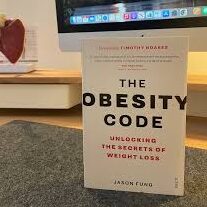Many people follow the “eat less, move more” rule when trying to lose weight, but this often fails to deliver long-term results. Dr. Jason Fung, in his book The Obesity Code, points out that the key issue with weight loss isn’t just the simple balance between calorie intake and consumption, but the role of insulin. Insulin not only regulates blood sugar levels but also affects fat storage and burning. When insulin levels are too high, even if you reduce calorie intake, the body still tends to store fat instead of burning it.
The limitations of “eating less and moving more
The traditional view suggests that if we consume fewer calories than we burn, we will lose weight. However, Dr. Fung argues that the human body is not as simple as a machine. When calorie intake is restricted, the body adjusts its metabolism by reducing energy expenditure to maintain balance. As a result, even with less eating and more exercise, the body enters a “starvation mode,” slowing down metabolism, which eventually leads to a weight loss plateau.
Even worse, frequent meals (even with fewer calories) still trigger constant insulin release, keeping insulin levels high. This directly leads the body to keep storing fat. High insulin is the main obstacle to weight loss, not just the calorie count
How to break the “eat less, move more” myth
1.Intermittent Fasting:
Intermittent Fasting is an effective strategy to lower insulin levels. By extending the fasting period, insulin naturally drops, and the body starts burning stored fat for energy. A common approach is the 16/8 method, where you fast for 16 hours and eat within an 8-hour window.
2.Low-Carb Diet:
Reducing carbohydrate intake, especially sugars and refined carbs, helps prevent sharp insulin spikes. Carbohydrates quickly break down into sugar, triggering insulin release and promoting fat storage. Therefore, a low-carb diet assists in controlling insulin and reducing fat storage.
Recommended foods:
- Protein: Chicken, fish, beef, eggs.
- Healthy fats: Avocado, olive oil, coconut oil.
- Non-starchy vegetables: Broccoli, spinach, cauliflower, cucumber.
- Nuts and seeds: Almonds, walnuts, chia seeds.
- Full-fat dairy: Cheese, butter, yogurt.
Foods to avoid:
- Sugar: Sugary drinks, desserts.
- Refined carbohydrates: White bread, white rice, noodles.
- Processed foods: Packaged foods high in sugar and salt.
3.Reduce meal frequency
Each meal triggers insulin release, especially when consuming high-sugar or high-carb foods. Therefore, reducing the frequency of meals and extending the time between them helps lower insulin levels, allowing the body more time to burn fat.
4.Improve Insulin Sensitivity
The lower your insulin sensitivity, the more insulin your body needs to process the same food. Improving insulin sensitivity is crucial for long-term weight loss. By increasing physical activity, reducing carbohydrate intake, and following a healthy diet, you can effectively enhance your body’s insulin sensitivity. This helps reduce insulin secretion and promotes fat loss.

The “eat less, move more” approach often fails because it overlooks the key role of insulin in weight management. To achieve healthy and sustainable weight loss, you must control insulin levels and enable your body to enter a fat-burning state. This scientific approach not only helps you break through weight loss plateaus but also ensures long-term weight maintenance and a healthier lifestyle.
Learn more about this book:How to Break Through a Long-Term Weight Loss Plateau
The content above was created by iWeaver Ai.




